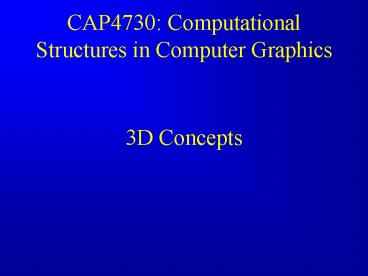CAP4730: Computational Structures in Computer Graphics PowerPoint PPT Presentation
Title: CAP4730: Computational Structures in Computer Graphics
1
CAP4730 Computational Structures in Computer
Graphics
3D Concepts
2
Outline
- Basic Idea of 3D
- Projections
- What are some things we didnt have to worry
about before? - What are some new things we can do?
3
Right Handed Coordinate System
Y
Y
Z
X
X
Z
4
Viewing a 3D world
Y
We have a model in this world and would like to
view it from a new position. Well call this
new position the camera or eyepoint. Our job is
to figure out what the model looks like on the
display plane.
X
Z
5
Parallel Projection
Y
Z
X
6
Perspective Projection
Y
Z
X
7
What are some new things to think about?
Hidden Surface Removal Visibility Depth Cueing
8
How to make a 2D image appear as 3D!
- Output is typically 2D Images
- Yet we want to show a 3D world!
- How can we do this?
- We can include cues in the image that give our
brain 3D information about the scene - These cues are visual depth cues
9
Visual Depth Cues
- Monoscopic Depth Cues (single 2D image)
- Stereoscopic Depth Cues (two 2D images)
- Motion Depth Cues (series of 2D images)
- Physiological Depth Cues (body cues)
10
Monoscopic Depth Cues
- Interposition
- An object that occludes another is closer
- Shading
- Shape info. Shadows are included here
- Size
- Usually, the larger object is closer
- Linear Perspective
- parallel lines converge at a single point
- Surface Texture Gradient
- more detail for closer objects
- Height in the visual field
- Higher the object is (vertically), the further it
is - Atmospheric effects
- further away objects are blurrier
- Brightness
- further away objects are dimmer
11
Stereoscopic Display Issues
- Stereopsis
- Stereoscopic Display Technology
- Computing Stereoscopic Images
- Stereoscopic Display and HTDs.
- Works for objects lt 5m. Why?
12
Stereopsis
The result of the two slightly different views of
the external world that our laterally-displaced
eyes receive.
13
Time-parallel stereoscopic images
- Image quality may also be affected by
- Right and left-eye images do not match in color,
size, vertical alignment. - Distortion caused by the optical system
- Resolution
- HMDs interocular settings
- Computational model does not match viewing
geometry.
14
Disparity
- If an object is closer than the fixation point,
the retinal disparity will be a negative value.
This is known as crossed disparity because the
two eyes must cross to fixate the closer object. - If an object is farther than the fixation point,
the retinal disparity will be a positive value.
This is known as uncrossed disparity because the
two eyes must uncross to fixate the farther
object. - An object located at the fixation point or whose
image falls on corresponding points in the two
retinae has a zero disparity.
15
Convergence Angles
f1
- ?acbd 180
- ?cd 180
- ?-? a(-b) ?1?2 Retinal Disparity
a
D1
f2
b
D2
a
b
c
d
?2
?1
i
16
Stereoscopic Display
- Stereoscopic images are easy to do badly, hard to
do well, and impossible to do correctly.
17
Stereoscopic Displays
- Stereoscopic display systems create a
three-dimensional image (versus a perspective
image) by presenting each eye with a slightly
different view of a scene. - Time-parallel
- Time-multiplexed
18
Time Parallel Stereoscopic Display
- Single Screen
- Two different images projected on the same screen
- Images are polarized at right angles to each
other. - User wears polarized glasses (passive glasses).
- Two Screens
- Each eye sees a different screen
- Optical system directs each eye to the correct
view. - HMD stereo is done this way.
19
Passive Polarized Projection Issues
- Linear Polarization
- Ghosting increases when you tilt head
- Reduces brightness of image by about ½
- Potential Problems with Multiple Screens (next
slide) - Circular Polarization
- Reduces ghosting but also reduces brightness and
crispness of image even more
20
Problem with Linear Polarization
- With linear polarization, the separation of the
left and right eye images is dependent on the
orientation of the glasses with respect to the
projected image. - The floor image cannot be aligned with both the
side screens and the front screens at the same
time.
21
Time Multiplexed Display
- Left and right-eye views of an image are computed
and alternately displayed on the screen. - A shuttering system occludes the right eye when
the left-eye image is being displayed and
occludes the left-eye when the right-eye image is
being displayed.
22
Stereographics Shutter Glasses
23
Motion Depth Cues
- Parallax created by relative head position and
object being viewed. - Objects nearer to the eye move a greater distance
24
Pulfrich Effect
- Neat trick
- Different levels of illumination require
additional time (your frame rates differ base of
amount of light) - What if we darken one image, and brighten
another? - http//dogfeathers.com/java/pulfrich.html
- www.cise.ufl.edu/lok/videos/pulfrich.avi
25
Physiological Depth Cues
- Accommodation focusing adjustment made by the
eye to change the shape of the lens. (up to 3 m) - Convergence movement of the eyes to bring in
the an object into the same location on the
retina of each eye.
26
Summary
- Monoscopic Interposition is strongest.
- Stereopsis is very strong.
- Relative Motion is also very strong (or
stronger). - Physiological is weakest (we dont even use them
in VR!) - Add as needed
- ex. shadows and cartoons
27
What are some new things we can do?
- Lighting and Shading!
- Texturing!
- Stereo
- Surfaces
- Normals
- Materials
28
(No Transcript)
29
(No Transcript)

